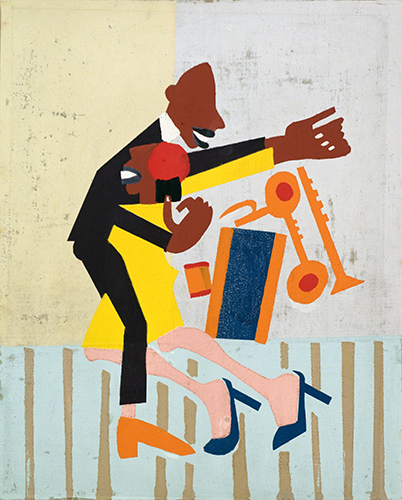African American History Month 2010: William Henry Johnson
The first time I saw the paintings of William H. Johnson, they were works from his expressionist period, the first time he lived in Europe (1926–1929). Needless to say, it was one of those “holy cow!” moments, because I find those expressionist landscapes awesome! As an exhibiting/selling artist, he did not have a heck of a lot success, either in Europe or America. He had a challenging, emotionally turbulent life, rather like van Gogh did, and, like van Gogh, he seems to have expressed some of that intensity of feeling through the vibrant colors he used in his painting.
 |
| William Henry Johnson (1901–1970, United States), Jitterbugs (No. 2), ca. 1941. Silkscreen on paperboard, 17" x 13 ¾" (43.2 x 34.9 cm). Photo © Philadelphia Museum of Art. (PMA-3868) |
Johnson was born in Florence, South Carolina. He discovered a love for drawing at an early age, but it was not until he was twenty that he could afford to start art training. He went to New York, which he considered to be the artistic center of the United States. He learned the rigid, disciplined way of painting at the conservative National Academy of Design.
Between 1924 and 1926 he won several important prizes for his painting while working in the studio of Ash Can School painter George Luks (1867–1933). Luks’s painterly canvases and recommendation to paint life’s moving experiences particularly influenced Johnson. Between 1926 and 1929 Johnson painted in Europe. He was drawn to the expressionist color and forms in the work of Chaim Soutine (1893–1943), and considered himself a primitive painter in the manner of Paul Gauguin (1848–1903). Although encouraged by another expatriate African American in Paris, Henry Tanner (1859–1937), Johnson never achieved the same success in Europe. Johnson won the Harmon gold medal in 1930. Beginning in the 1920s, the Harmon Foundation, a white philanthropic group, had sponsored yearly exhibits called “Negro Art.”
Like many artists of the Harlem Renaissance, he worked on WPA mural projects from 1939 to 1943. Jitterbugs reflects the radical change Johnson adapted in his work during the late 1930s. After seeing Jacob Lawrence’s (1917–2000) Harlem scenes, Johnson abandoned the Soutine-type of Expressionism for one which reflected black life and culture. The emphasis on music, especially jazz, reflected Johnson’s pride in what he considered a uniquely African American art form. The simplified forms reflected Horace Pippin’s naïve paintings and Lawrence’s use of flattened shapes. The distorted space reflects the lingering European influences of Expressionism and Cubism. Johnson produced paintings of the Jitterbugs subjects and the subsequent prints after those paintings were widely popular.
Check out a nice retrospective of Johnson’s work that shows his progression from Expressionism to simplified abstract forms from the Smithsonian American Art Museum.


Comments